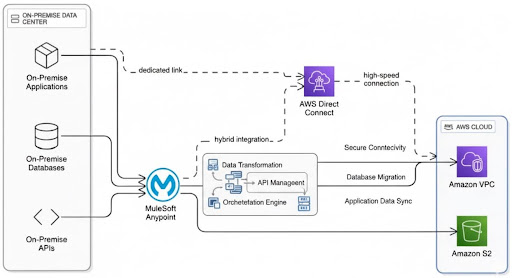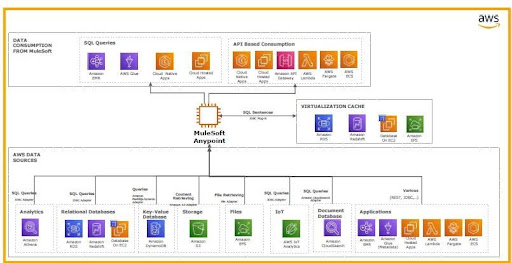Over the past decade, organizations across industries have widely adopted a cloud-first strategy as a cornerstone of digital transformation and modernization.
The promise is compelling: enterprises migrating to major cloud providers anticipate a unified, powerful platform that enables innovation, scalability, flexibility, and optimized infrastructure costs. By shifting workloads to the cloud, businesses aim to devote more energy to innovation and less to maintaining physical infrastructure.
Yet the reality is more complex. While the cloud delivers undeniable benefits, a poorly executed cloud-first strategy can introduce new challenges. Cloud platforms are vast ecosystems composed of hundreds of discrete, highly specialized services. Orchestrating these services requires deep, low-level developer expertise.
Without a strategic integration approach, this quickly results in “intra-cloud” integration sprawl. Teams build custom, point-to-point connections for each project, creating a fragile web of brittle integrations that are costly to maintain. This lack of governance and reuse undermines the very agility the cloud was meant to provide, leaving organizations with a complex, fragile, and expensive cloud ecosystem.
With MuleSoft’s Anypoint Platform, organizations gain a unified integration layer that brings order to their cloud ecosystem investments. It abstracts complex, low-level cloud interactions and transforms them into governed, reusable APIs and workflows, enabling faster digital transformation, lower integration costs, and greater reliability across services.
A maze of complexity in a sea of cloud services
Committing to a cloud-first strategy to modernize your IT environment is a wise strategic move. But the work has just begun. The challenge is no longer choosing a cloud, but mastering the one or the ones you’ve chosen.
The hidden complexities of a cloud platform
Many organizations discover that adopting a cloud-first approach is not a silver bullet. The transition often requires overcoming significant challenges:
- “Sea of services”: Cloud providers offer hundreds of services, each with unique APIs, security models, and operational nuances. Integrating these services into a seamless, reliable workflow can be complex and time-consuming
- Developer bottleneck and low-code skills gap: Native cloud integration services and tools are built for developers, often requiring specialized skills. As a result, every integration request from the business becomes a ticket in a backlog, waiting for a specialist with the right coding expertise, creating a significant bottleneck to innovation
- Rise of point-to-point sprawl: Under project pressure, developers create the quickest possible connections between services. These integrations are rarely documented, governed, or designed for reuse. The result is a hidden technical debt that makes the system fragile and difficult to change
- Limited visibility: A single business process might span five different cloud services, each with its own logs and metrics. It’s nearly impossible for a business analyst or even an IT leader to see the end-to-end flow, identify bottlenecks, troubleshoot issues effectively, or ensure compliance
From migration to cloud orchestration
Without a strategic integration layer, organizations face increased operational costs, reduced agility, higher risk of failures and security vulnerabilities, limited scalability and reuse, and delayed innovation. But Anypoint Platform provides a unified solution to manage the entire cloud journey from the initial move to the cloud to sophisticated orchestration within it.
Seamless cloud migration
Before data, workloads, and digital assets can be fully leveraged in the cloud, they must first be migrated there. Cloud adoption is rarely a “lift-and-shift” exercise, it’s a foundational step in digital transformation that requires careful planning, phased execution, and minimal disruption to ongoing operations.
MuleSoft’s API-led connectivity abstracts legacy systems and decouples dependencies, enabling organizations to securely migrate data, applications, and business workloads to the cloud or even across multiple cloud environments. This approach not only ensures continuity during migration but also creates a flexible integration layer that accelerates modernization and unlocks the full potential of a cloud-first strategy.
- System APIs are used to create a stable, modern REST API facade for your on-premise legacy systems
- Process and Experience APIs consume these System APIs to run your business
- Incremental migration: Move data and systems to the cloud gradually, updating only the relevant APIs or configurations without disrupting existing applications.
For example, when migrating a legacy database to a cloud service such as Amazon RDS, the only adjustment required is updating the configuration of the System API to point to the new cloud database. All applications consuming that API remain completely unaware and unaffected. This approach eliminates the “big bang” risk often associated with traditional migration projects

Orchestrate your cloud system
Once your applications and data are in the cloud, MuleSoft becomes the central orchestrator, simplifying how everything communicates.
| Capability | The cloud without MuleSoft | The cloud with MuleSoft |
| Connecting services | A developer writes custom code using the AWS SDK to connect Service A to Service B. This requires deep platform expertise. | An integration specialist uses MuleSoft’s pre-built, certified connectors to visually connect Service A to Service B. The complexity of the SDK is abstracted away. |
| Building a workflow | A complex workflow is built with tools like AWS Step Functions, which requires learning a specific JSON-based syntax and is difficult for non-specialists to visualize. | The entire business workflow is designed as a single, graphical flow in Anypoint Platform. It’s easy to understand, modify, and troubleshoot for a wider audience. |
| Governance and security | Security policies must be configured separately for each microservice or function, leading to inconsistencies. | A single security policy is created in MuleSoft and applied to any API, regardless of whether it fronts a Lambda function, an RDS database, or an on-prem system. |
| Reusability | A Lambda function written for Project X is rarely discovered or reused for Project Y. The logic is built all over again, wasting time and money. | An API built in MuleSoft gets published to the Anypoint Exchange, making it discoverable and reusable by any developer for any future project. |

Business agility and operational excellence
Adopting a unified integration approach with MuleSoft Anypoint delivers clear, measurable benefits:
- Accelerate project delivery: Free your expensive cloud developers from writing boilerplate integration code. Empower integration teams to rapidly deliver projects by composing new applications from reusable APIs.
- Reduce overhead maintenance: A single, governed, and well-documented integration flow in MuleSoft is vastly easier and cheaper to maintain than a dozen scattered, custom-coded serverless functions.
- Lower Total Cost of Ownership (TCO): Eliminate redundant work, reduce dependency on niche developer skills, and gain operational efficiency through a centralized platform for monitoring, logging, and governance.
- Future-proof architecture: MuleSoft acts as an abstraction layer. If the integration strategy changes, such as swapping a cloud service (e.g. from Amazon SQS to Azure Service Bus), only the MuleSoft flow needs to be updated, while all-consuming applications remain unchanged.
- Democratize innovation: By making integrations easier to build and understand, more people across the organization can participate in developing digital solutions, helping to eliminate the developer bottleneck.
Mastering the cloud with MuleSoft
A disciplined cloud-first strategy, focused on integration and data governance, creates a scalable digital ecosystem. This ensures lasting value, moving beyond simple migration to truly modernize operations.
With MuleSoft as the integration and orchestration strategy, organizations move beyond simply being in the cloud to truly mastering the cloud. MuleSoft provides a resilient, secure, and agile digital foundation ready for whatever comes next. It doesn’t replace cloud services – it amplifies their value, serving as the orchestration engine that makes them work together seamlessly, reliably, and efficiently.









